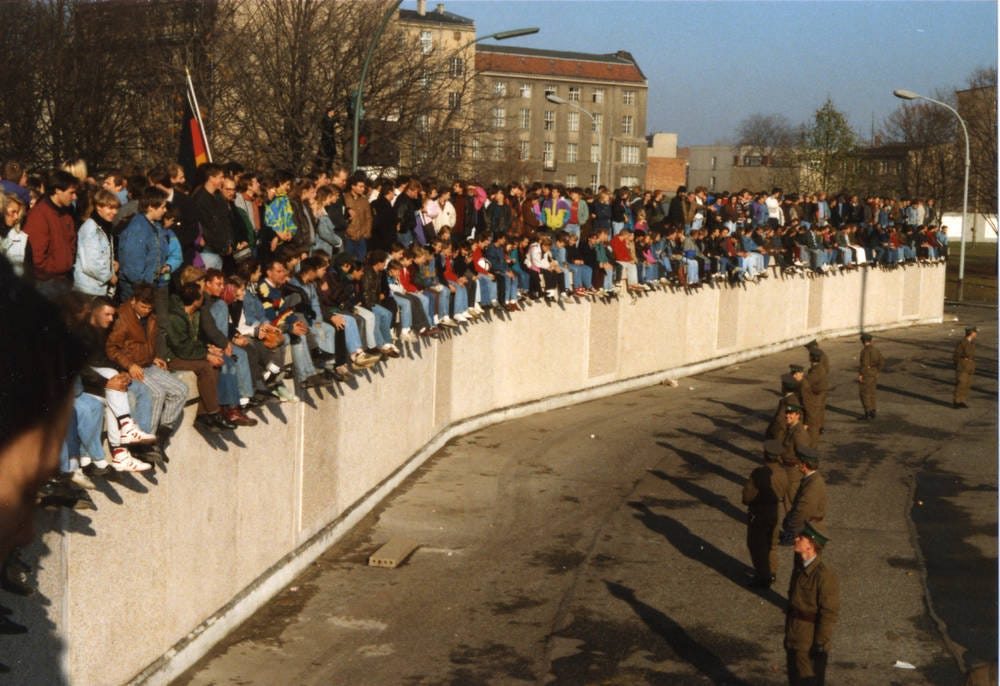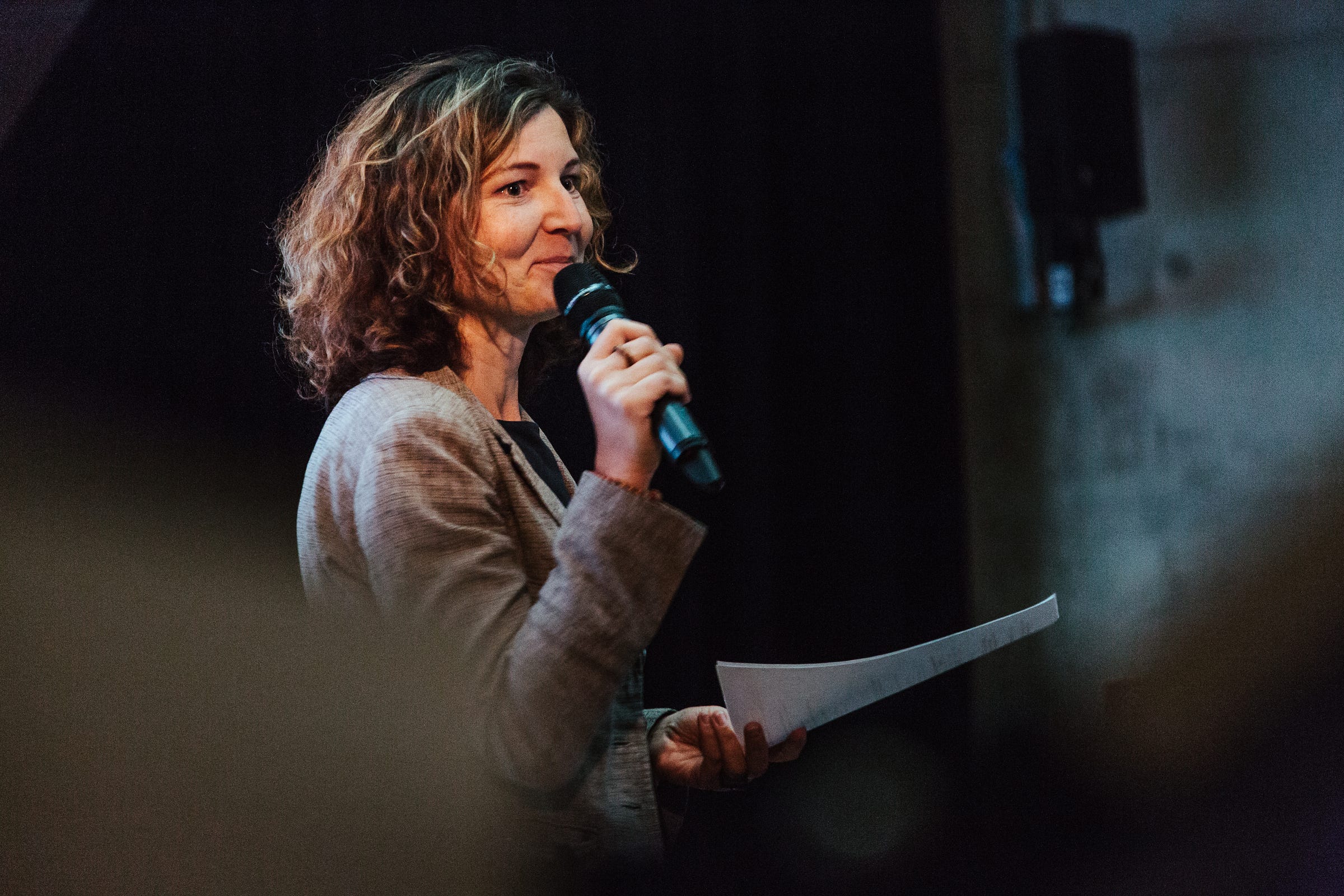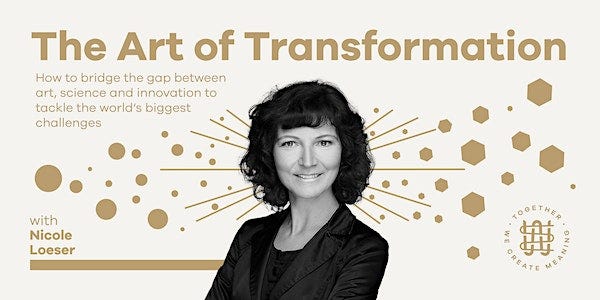In the run-up to our upcoming event on August 17, I spoke with Institute for Art and Innovation co-founder Nicole Loeser on the Art of Transformation. In our conversation, we traversed a falling Berlin Wall and collapsing political systems, guided by the question of how art can inspire systemic change and innovation. As the climate emergency continues to worsen and scientists realize that facts alone aren’t enough, people are increasingly turning to artists for answers. The artist weaves new stories and waves her magic paintbrush, yielding the power to transform consciousness and systems. But as Nicole emphasized, this is only possible when artists work across disciplines and focus on the most pressing challenges of the moment.
Messages across borders
Nicole was born in the former GDR, “a country that doesn’t exist anymore”, she reminded me, smiling, and grew up in an era of radical political and economic changes. Berlin has always been a magnetic center of creativity, but the socialist system in former East Berlin put a heavy limit on self-expression through censorship and prosecution. During that time, it was the artists who created underground spaces to explore divergent political ideas and alternative futures. “I went to my first concerts before 1989”, Nicole explains, “and I figured out quite fast that there were messages delivered through the lines. So what I liked was that there were people — artists, poets, and musicians alike, who could somehow deal with this political and oppressive system and were able to address certain topics that were not really system-conform.”
“Before the wall came down, I was living in Pankow where I was friends with sons and daughters of intellectuals and authors who were also the progressive voices of that time. So I started to partake in demonstrations and went to parties where we discussed different opportunities for this system that we saw as broken. We demanded systemic changes and tried to envision a country where things would go differently, but we never expected to become part of the other German side. So when the wall came down I would say I was not eager at all to become a member of the other Germany, which depended — and still depends on a capitalistic system.”

I also remember the first time on November 10th, 1989 when I went to West Berlin. I was super excited and nervous, of course, because it was totally unbelievable that it was actually possible to cross the border. I did that in Bornholmer Straße — one of the first entry points. Later I also took the underground through West Berlin. What was really scary to me was that I saw faces that were even more disillusioned and gray than in the GDR. The question that I asked myself at that time was, is that truly the society everyone was looking or giving up life in East Germany for?”
When hundreds of thousands of people gathered to demand democratic socialist reform, few imagined that shortly after the wall would collapse, an entire generation raised under socialism would suddenly be catapulted into a wholly different system. As Nicole says, “On one hand, it was a great time when no rules and no laws existed in East Berlin. And then in the nineties, you were a kind of member of this other part, but you didn't feel in the right place. You were not prepared for this capitalist system… But even though we didn’t feel part of this other system, we tried our best to hold together and create our own kind of ecosystem. We were starting our own bands which were well-connected to lots of other bands and artists. It was all about these dreams about freedom. In Mitte and Prenzlauer Berg were lots of old, abandoned flats and buildings where we always found a way to make music or exhibit bits and pieces. Even though it was somehow a sad time because of many reasons, it was also a cool time to explore new opportunities.”
As Nicole was speaking, I imagined an image of West and East Berlin with abandoned buildings in the transit zone between both sides, taken over by artists and musicians. Shattered glass and graffitied walls. All quiet but the punk music that reverberates through broken windows. A young generation that lost the old ways tries to make sense of the moment; the unknown. They sing their new songs for humanity in search of a new foothold and guiding vision. This image somehow made me think of the times we are in now, and the role of artists in responding to the liminal space in which the old world is breaking down and the new is emerging in the distance. How can art help us transform into new realities?
Artists as change catalysts
“I think artists can shed light on important issues, and sometimes I would say that I demand that from artists in the 21st century. It’s really about how we can change consciousness, change perspectives, and change behavior together so that we truly put mental health, social justice, or environmental protection in focus.” Art, we agreed, can still be a tool for self-expression and a vehicle to capture and transmit life’s beauty. “But when you put art in a public space”, Nicole remarked, “then we need art that is linked to something meaningful, because in my opinion, art could be a tool that allows us to grow, and at the moment we need different growing models.”
“We have to think outside the box, and it's only possible when we can inspire each other from different disciplines and cultural backgrounds. To step out of old structures, and really start imagining positive futures and experimenting with new pathways together.”
“Art is a tool to remind ourselves how we can connect to our core and to our natural and social environment. My hope is that artists are capable of feeling what is needed for the hive, for the community, for nature, and for the planet as a whole. And I think that's why I initiated and have been realizing all these EU projects because I sense that I can help people to communicate, collaborate, and overcome communication issues or work across different mentalities and logics. It was important for me that I played an instrument, wrote my screenplays, painted, and curated numerous exhibitions with progressive artists around the world. But I now use my artistic and curatorial approach to co-create for broad system innovation. We have to work more interdisciplinary to generate radical change ideas. That’s why I initiate interdisciplinary projects. Art is always integrated because it can help people envision and prototype desirable futures. Years ago I recognized that in many innovation projects art didn't play a role at all.”
Nicole co-founded the Institute for Art and Innovation (IFAI) to bridge different worlds and co-create transformative change. To do so, she says, “We have to think outside the box, and it's only possible when we can inspire each other from different disciplines and cultural backgrounds. To step out of old structures, and really start imagining positive futures and experimenting with new pathways together.”
Move like water
Observing the magnificence of whales firsthand, coupled with the stark reality of their decline, motivated Nicole to embark on a mission to safeguard the oceans and advocate for access to healthy waters. “It’s amazing when you think about whales and how they’ve been on earth for more than 5 million years, while the humans we’d say we can relate to have only been around for about 40,000 years. And yet we harm them, right?”. Earlier this year, she attended the UN water conference where more than 8,000 environmental ministers, water managers, and conservationists came together to address pressing water-related challenges and develop strategies for better water governance and management. The Institute for Art and Innovation co-initiated the Ocean Future Lab, an interdisciplinary and participatory think-tank dealing with the future challenges facing the earth’s oceans.

“We can learn from water to pool different sources of knowledge, expertise, and resources, and create new streams to overcome challenges.”
Throughout my conversation with Nicole, I realized that water was not just an area of concern but a metaphorical characteristic that defines her and the work she does. It seeped through the silences between her phrases and connected her streams of thought. Like water, Nicole is someone who seeks to connect across seeming divides; to catalyze transformation through the touch and contact between unlikely forces. “We can learn from water to pool different sources of knowledge, expertise, and resources, and create new streams to overcome challenges.” While we usually only see the water drops or a very specific issue, art, she believes, can help us see the bigger picture, to perceive both the streams and rivers as well as the lakes and oceans that receive them. This is a crucial perspective and capability in these times. We are waking up to the interconnectedness of the world and the global challenges we face. Every issue is tied to another, yet so are the solutions. Who are the others on your co-creative journey?
The Art of Transformation is an opportunity for you to learn more about Nicole’s work and dive deeper into the topics of interdisciplinary transformation where art is at the center. Join us on August 17 at We Create Meaning for another evening of dialogue and networking. Click the button below to register.
This article is written and edited by Create Meaning’s community writer
. If you value these publications, consider subscribing to our newsletter and getting the Supporter ticket at checkout to support our work.






I totally get what Nicole could have experienced because it is similar in other countries. First you're fascinated that on the "other side" where artists could express their individuality, realizing that artists are again a tool for system-relevance.
We are ONE HUMAN FAMILY NOT A reversed-engineered system-concept of "We Are The World." We grow up for generations being conditioned that our art-product is a commodity that proves that we are an artist or worthy of being called an artist by all our man-made systems like states, businesses, religions, politics etc.
The truth is that we are human-centrically all COLLABORATIVE CREATOR-ANIMALS of NATURE. We can’t save nature because we are a part of it. The only thing we can do is live in harmony with nature to protect our original habitat and water, air and food to allow our species to survive and flourish for generations. If not, nature keeps going, like it did with dinosaurs not adapting.
Artists need to wake up to the fact that the art-product is a commodity for systems. Our human-centric worth is not in our art-products but in unveiling our Selves within the creation process. The true human-centric value is found in the art-creation and experiencing the artist community of creatives and craftsmen. Why? Because art/creation is an inherent muscle that when we create collaboratively art it reveals the blueprint of what's humanly possible, thereby, lifting our human potential. Beautiful Thank you.
Michaell Magrutsche Austrian/Californian artist, speaker, author and strategist. https://MICHAELLM.com